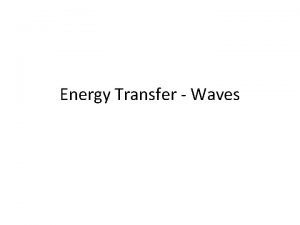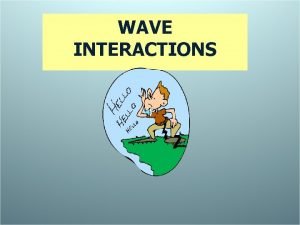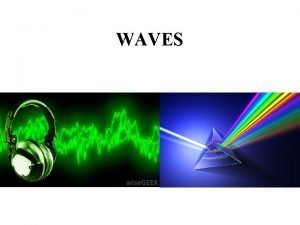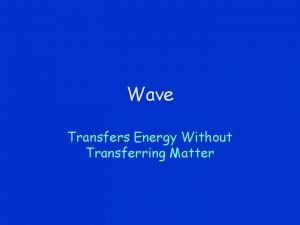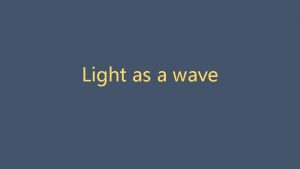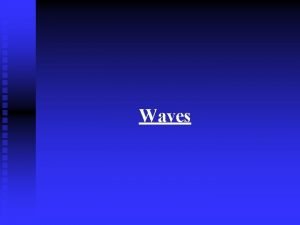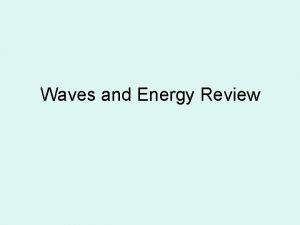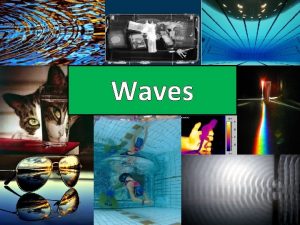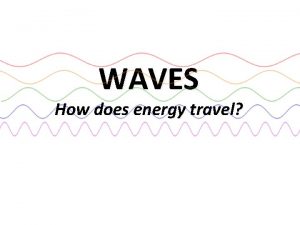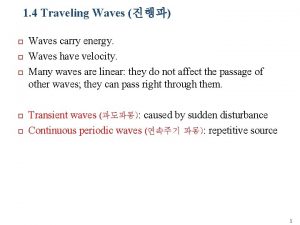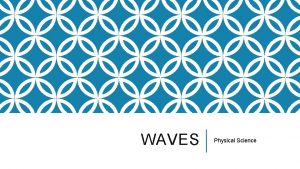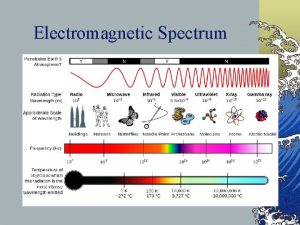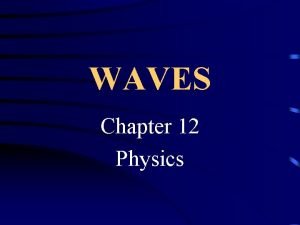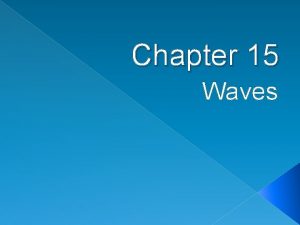Chapter 12 Waves and Energy Transfer Energy Transfer



















- Slides: 19

Chapter 12 Waves and Energy Transfer

Energy Transfer • Energy is transferred by particles or waves. Types of Waves ¬Mechanical Waves ¬Electromagnetic Waves

Mechanical Waves • Water waves, sound waves, waves in a rope or spring. • Requires a medium • ie. : Water, air, rope, spring Types of Mechanical Waves:

Transverse Waves • Particles in medium vibrate perpendicular to direction of wave motion. • Example: guitar string.

Transverse Waves Wavelength Crest Equilibrium Wavelength Amplitude Trough Crest: The highest point on a transverse wave. Trough: The lowest point on a transverse wave. Amplitude: The maximum displacement of a transverse wave from it’s equilibrium position.

Longitudinal Waves • Particles in medium vibrate parallel to direction of wave motion. • Example: sound wave.

Longitudinal Waves Compression: Area on a longitudinal where the medium is compressed. Rarefaction: Area on a longitudinal wave where the medium is spread out. Compression Rarefaction Wavelength

Surface Waves • A mixture of longitudinal and transverse waves. • The particles move in circles. • Example: ocean wave. Mechanical Wave Simulation - http: //www. acs. psu. edu/drussell/Demos/wavemotion. html

Electromagnetic Waves • Gamma, X-Ray, UV, Light (ROYGBIV), Infrared, Micro, Radio • No medium required. They are waves in the electromagnetic field. • Travel at the speed of light. • 299, 792, 458 m/s • 3. 0 x 108 m/s

Properties of Waves Period (T) • Time needed for wave to repeat itself. • Measured in seconds. Frequency (f) • • # of vibrations per second. Measured in Hertz. 1 Hz = 1 vibration/second f = 1/T Wavelength (λ) • The length of a wave between two similar points on a wave.

Wave Speed • The speed of a mechanical wave does not depend on amplitude or frequency. • Speed depends on the properties of the medium. ¬v: velocity ¬f: frequency ¬ : wavelength

Wave Reflections • When a wave encounters a fixed end it will reflect inverted. • When a wave encounters a free end it will reflect erect.

Constructive Interference • Occurs when wave displacements are in the same orientation. • Result is a wave with a larger amplitude. (sum of the individual amplitudes) • After the pulses have passed through each other, they regain their original shape and size.

Destructive Interference • Occurs when wave displacements are in the opposite orientation. • Result is a wave with a smaller amplitude. (difference between the individual amplitudes) • After the pulses have passed through each other, they regain their original shape and size.

Standing Waves • Result from the interference of identical waves travelling in opposite directions. • Contain positions where the medium has zero displacement throughout the waving.

Antinode Wavelength Node – position where the medium has zero displacement while the waves pass through each other. Antinode – position where the medium has maximum displacement while the waves pass through each other.

Waves and Music • The frequency of a wave determines the pitch you hear. • The amplitude of a wave determines the loudness of the sound. • Standing waves are created on strings and in tubes to create musical notes. • The properties of the waves are determined by the geometry of the instrument and the wave’s behavior at boundaries.

Waves on Strings are fixed at both ends, meaning the standing wave pattern must have a node at each end. Can you draw a standing wave with nodes at each end? http: //www. acs. psu. edu/drussell/Demos/Standing. Waves. html

Waves in a Tube At an open end of a tube, the standing wave will have maximum displacement (antinode). At a closed end of a tube, the standing wave must have zero displacement (node). Can you draw a standing wave with antinodes at both ends? Can you draw a standing wave with a node and antinode at opposite ends? http: //www. acs. psu. edu/drussell/Demos/Standing. Waves. html
 Compare and contrast p waves and s waves using venn diagram
Compare and contrast p waves and s waves using venn diagram Characteristics of mechanical waves
Characteristics of mechanical waves What transmits energy without transferring matter
What transmits energy without transferring matter Energy energy transfer and general energy analysis
Energy energy transfer and general energy analysis Energy energy transfer and general energy analysis
Energy energy transfer and general energy analysis Example of mechanical wave
Example of mechanical wave Mechanical and electromagnetic waves similarities
Mechanical and electromagnetic waves similarities Carbon dioxide temperature
Carbon dioxide temperature Difference between matter waves and electromagnetic waves
Difference between matter waves and electromagnetic waves Similarities of mechanical and electromagnetic waves
Similarities of mechanical and electromagnetic waves Seismic waves
Seismic waves Venn diagram of mechanical and electromagnetic waves
Venn diagram of mechanical and electromagnetic waves Difference between constructive and destructive waves
Difference between constructive and destructive waves Wave transfer matter
Wave transfer matter Rate of energy transfer by sinusoidal waves on strings
Rate of energy transfer by sinusoidal waves on strings Repeating disturbance that transfers energy
Repeating disturbance that transfers energy Waves transfer energy without transferring
Waves transfer energy without transferring Do light waves transfer energy
Do light waves transfer energy Light waves are transverse waves true or false
Light waves are transverse waves true or false The wave chapter 13
The wave chapter 13


